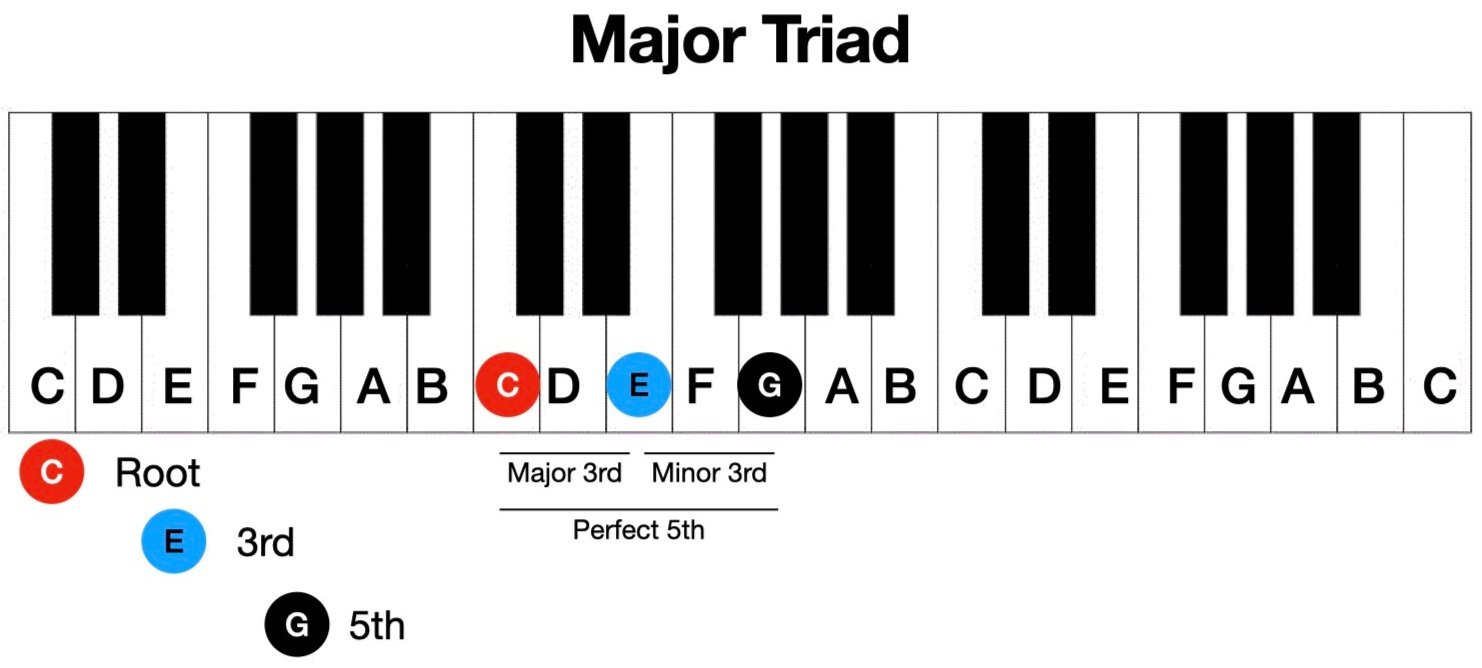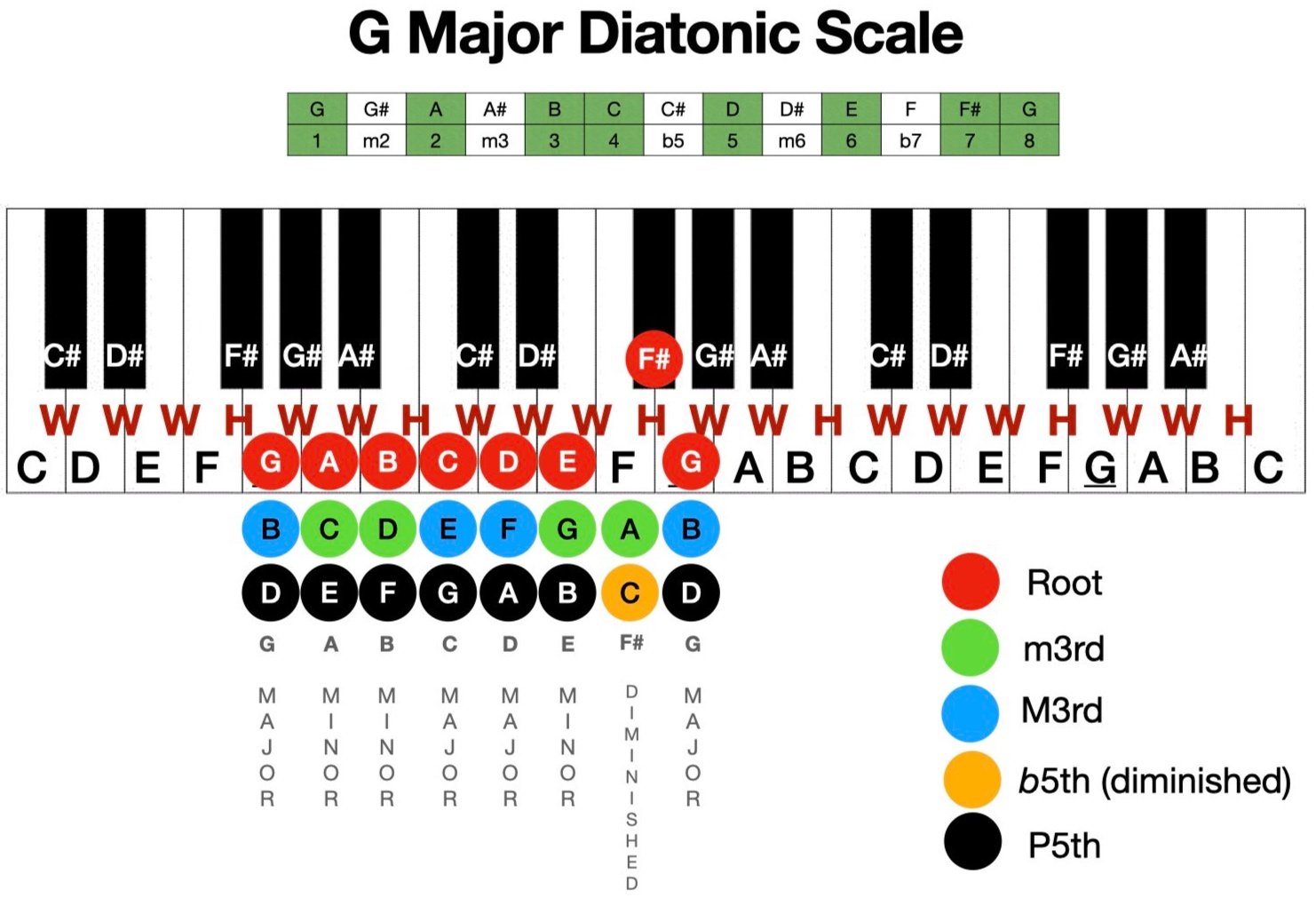2. Intervals and Chord Harmony
This series focuses on the building blocks of how music works (Western music, that is European and the Americas). We started the series defining the basic terminology of how musicians describe and communicate music. Understanding the terms and how to use them will open the door to better understanding of how music works and to creating more expressive melodies.
In this article we will continue looking at the terms based on the major scale:
The Major Scale Intervals
The importance of the major 3rd and minor 3rd Intervals
Basic Chord Construction and Harmony (Triads)
A Review of Fundamental Terms of Music
In the previous Blog, we discussed the major scale as the basis for the terminology of scales, chords, and harmony and that the major scale comprises seven tones A to G and five notes in between some of the letter notes demarcated by a “♯” (sharp) or a “♭” (flat). Each of the seven scale notes (scale degrees) are numbered in some cases with roman numerals (I, II, III, IV, V, VI, VII) and in other cases with Arabic numerals as shown below.
C D E F G A B
1 2 3 4 5 6 7
Again, we will base our discussion around the C major (Ionian) scale to avoid ♯’s and ♭’s. The C major scale is easy to visualize on the piano because it only uses the white keys. The black keys are not part of the diatonic C major scale (diatonic meaning in the key). An example of the C Major scale is shown below. Please refer to the previous Blog, titled “Let’s Talk Music” for more details.
We closed the previous Blog with the diagram below as a brief introduction to the major scale intervals and how they are named. The interval names and understanding their relationships is the basis of building harmony and chords. The table below presents the names of each chromatic scale tone within the major scale structure. We will expand on the different musical intervals for the major scale to discuss chords and harmony.
C Major Diatonic Scale
Above we have the C Major scale labeled for each interval along with common terms you will see in various publications. For this series of articles, we will generally use the symbology highlighted in the column on the far right, but the Alternative Names will be noted when they are the more commonly used terms (confusing I know but bear with me). The diagram above shows each interval relative to the major scale root note. If we focus on the C major scale and the relevant intervals we have the notes C D E F G A B C where C to D is a Major 2nd, C to E is a Major 3rd, etc. Understanding these relationships is important.
Harmony and Building Chords (Triads)
In Western music, simple harmony is based primarily on major or minor third intervals. The chords we learn first are based on triads or three tones. Each basic triad has a root, 3rd, and a 5th. More complex chords and extended chords may have more tones but we will stay with the basic triad of root, 3rd, and 5th for now.
For example a C major chord includes the notes C E G where C is the root, E is a major third above C, and G is a perfect 5th above C (see diagram below). But we also want to note that the Perfect 5th note G is a minor 3rd interval above the 3rd note E in the C chord. This relationship will always be true of the intervals in a major chord.
A Major 3rd interval is 4 half-steps or 4 semi-tones (e.g: four frets on a guitar)
A Minor 3rd interval is 3 half-steps or 3 semi-tones (e.g: three frets on a guitar)
A minor chord, for example A minor, includes the notes A C E where A is the root, C is a minor third above A and E is a Perfect 5th above A (see diagram below). We also want to note that the Perfect 5th E is a major 3rd above the 3rd note C. This relationship will always be true of the intervals in a minor chord.
Now you will see that you can make the diatonic chords (triads) of the C Major scale by starting on any note in the scale and skipping a note to the 3rd and skip another note to the 5th. This gives us the diatonic chords of the C Major scale as shown on the next diagram.
Major chords will be the root note, 4 semi-tones to the 3rd, and 3 semi-tones to the 5th.
Minor chords will be the root note, 3 semi-tones to the minor 3rd, and 4 semi-tones to the 5th.
Diminished chords will be a root note, 3 semi-tones to the minor 3rd, and 3 semi-tones to the ♭5th.
From the diagram above, we see the seven diatonic chords based on the major scale. Musicians commonly refer to the chords based on the scale degree where the chord is rooted. For example, in the diagram above, the C major chord is the I (or 1) chord, the D minor chord is the ii (or -2) chord and so on. Notice that the C, F, and G chords (I, IV, and V) are all major and the D, E, and A chords (ii, iii, vi) are all minor. The B chord is a diminished chord with a ♭5th note and is usually not discussed until you get deep into chord functions.
We can translate these relationships to any major key because the I, IV, and V (1, 4, 5) chords are always major and the ii, iii, and vi (-2, -3, and -6) chords are always minor. This is because the chord tones are all within the major diatonic scale. (Note: There are other types of major scales which will be discussed later in the series).
So, let's take a quick look at the key of G Major. Below is a diagram of the diatonic chords for the key of G (G has one sharp tone F#). The I, IV, and V chords (G, C, and D) are major and the ii, iii, and vi chords (Am, Bm, and Em) are minor. The vii chord is diminished (F#dim).
If we look at the relationship of the chords and the scale degrees, we get the diagram below. This diagram shows how the tones of each diatonic chord relate to the major scale where we use the C Major scale for reference. Also, shown are individual chord tones to the major scale degrees .
This diagram shows the relationship of each chord in a diatonic (Ionian) major scale and what scale degrees are in each diatonic chord. For instance, the I chord is made up of the 1, 3, and 5 tones of the scale and the vi chord is made up of the 6, 1, and 3 tones of the scale. This is an important relationship to understand when we look at chord functions in a progression and how the various chords and a melody are related. More on that in the next post.
Closing
So, this article is jammed packed with the backbone information of how basic triad chords are spelled and how the diatonic chords of the major (Ionian) scale are always I (major), ii (minor), iii (minor), IV (major), V (major), vi (minor), and vii (diminished). In future Blog installments, we will look into the function of the chords in chord progressions, and how the melody can guide which chord or chord inversion (next Blog) is best to support the melody.
For a visual presentation on this topic, I’ll refer you to a YouTube video by David Bennett Piano. He moves through the material quickly and uses the piano as his demonstration instrument. If MSA members are interested in how this relates to the guitar or other stringed instruments, contact Joe through MSA and he will consider creating a video if enough folks are interested.







